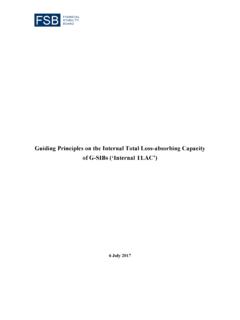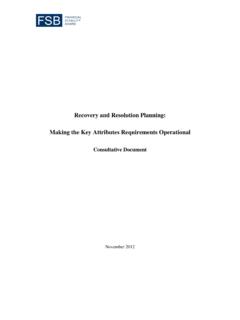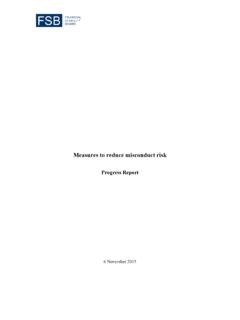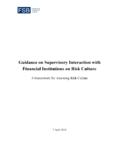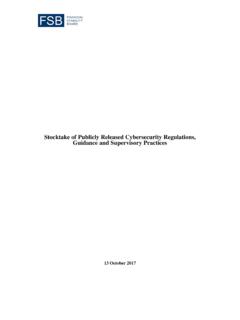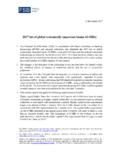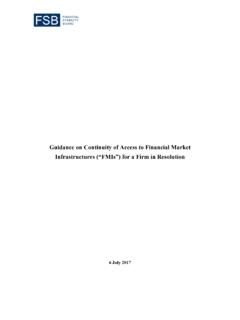Transcription of II-Annex 1: Resolution of Financial Market Infrastructures ...
1 II-Annex 1 Resolution of Financial Market Infrastructures (FMIs) and fmi participants Excerpt from Key Attributes of Effective Resolution Regimes for Financial Institutions II-Annex 1: Resolution of Financial Market Infrastructures (FMIs). and fmi participants Part I of this Annex ( Resolution of Financial Market Infrastructures ) provides guidance on the implementation of the Key Attributes of Effective Resolution Regimes for Financial Institutions (the Key Attributes', KAs) in relation to Resolution regimes for systemically important FMIs. Part II of this Annex ( Resolution of FMI Participants ) deals with the Resolution of FMI.
2 Participants that could be systemically significant or critical in the event of failure. I. Resolution of Financial Market Infrastructures The Key Attributes state that FMIs defined to include payment systems, central securities depositories (CSDs), securities settlement systems (SSSs), central counterparties (CCPs) and trade repositories (TRs) should be subject to Resolution regimes that apply the objectives and provisions of the Key Attributes in a manner appropriate to FMIs and their critical role in Financial markets (KA ). This guidance supplements the Key Attributes which apply generally to Resolution regimes for all systemically significant or critical Financial institutions, including FMIs - by indicating how particular KAs, or elements of particular KAs, should be interpreted when applying to Resolution regimes for FMIs or specific classes of FMI.
3 The presumption is that all FMIs are systemically important or critical, at least in the jurisdiction where they are located, typically because of their critical roles in the markets they serve. However, an authority may determine that an FMI in its jurisdiction is not systemically important or critical and, therefore, not subject to the Key Attributes. The scope of the guidance is aligned with that of the CPSS- IOSCO Principles for Financial Market Infrastructures (PFMI) 13 and makes clear that FMIs owned and operated by central banks are not subject to the Key Attributes.
4 Where relevant, this guidance sets out specific features of Resolution regimes appropriate for different types of FMIs. This Annex should be read with the Key Attributes, and the guidance on individual KAs should be considered in conjunction with the KA to which it relates. The Annex does not replace the Key Attributes, and there should be no inference that a particular KA or element of a KA does not apply to an FMI simply because there is no supporting provision in this Annex. 14. This Annex should also be read alongside PFMI which require systemically important FMIs to have a comprehensive and effective recovery plan.
5 15 More specifically, the PFMI require 13. 14. Where components of this Annex have been deemed important for purposes of assessing compliance with the Key Attributes, those components are explicitly reflected in the Key Attributes Assessment Methodology. 15. Further guidance on the recovery planning process and the content of recovery plans is set out in the CPMI- IOSCO report on Recovery of Financial Market Infrastructures . [To add hyperlink when guidance is published.]. 57. II-Annex 1 Resolution of Financial Market Infrastructures (FMIs) and fmi participants FMIs to establish explicit rules and procedures that address fully any credit losses they may face as a result of any individual or combined default by participants with respect to any of their obligations to the FMI; how potentially uncovered credit losses would be allocated; and how Financial resources that the FMI may deploy during a stress event are replenished.
6 16 The PFMI also require FMIs to establish explicit rules and procedures that enable the FMI to effect same-day, and where appropriate, intra-day and multi-day settlement of payment obligations on time following any individual or combined default among its participants. 17. Nevertheless, there may be circumstances where Resolution of the FMI is necessary. Entry into Resolution should be possible, subject to determination by the relevant authorities, if the recovery plan and any rules and procedures for loss allocation have failed to return the FMI to viability or have not been implemented in a timely manner, or the relevant regulator, oversight, supervisory, or Resolution authority determines that, even though the plan may not yet have been fully implemented or exhausted.
7 Recovery measures are not reasonably likely to return the FMI to viability or would otherwise be likely to compromise Financial stability. This requires FMIs to be subject to Resolution regimes that apply the objectives and provisions of the Key Attributes in a manner as appropriate to FMIs and their critical role in Financial markets (KA ). 1. Objectives (KA Preamble). An effective Resolution regime for FMIs should pursue Financial stability and allow for the continuity of critical FMI functions without exposing taxpayers to loss, either by restoring the ability of the FMI to perform those functions as a going concern or ensuring the performance of those functions by another entity or arrangement coupled with the orderly wind-down of the FMI in Resolution .
8 It should, as applicable, aim to: (i) achieve continuity and timely completion of critical payment, clearing, settlement and recording functions;. (ii) facilitate the timely settlement of obligations of the FMI;. (iii) maintain continuous access of participants to securities or cash accounts provided by the FMI and securities or cash collateral posted to and held by the FMI that is owed to such participants;. (iv) avoid any disruption in the operation of links between the FMI in Resolution and other FMIs that would have a material negative effect on Financial stability or the functioning of markets; and (v) safeguard, preserve and enable continuous processing of, and access to, data stored in a TR.
9 16. Principle 4, Key Consideration 7. 17. Principle 7, Key Consideration 10. 58. II-Annex 1 Resolution of Financial Market Infrastructures (FMIs) and fmi participants 2. Scope of Resolution regimes for FMIs (KA 1). Application to systemically important FMIs FMIs that are systemically important should, irrespective of their licensing status (for example, FMIs licensed as banks), be subject to a Resolution regime that applies the Key Attributes in a manner appropriate to the specific characteristics of the type of FMI in question and its critical role in Financial markets.
10 The Resolution regime should include the features that are relevant to the specific types of FMI covered by the scope of that regime. The Key Attributes and Guidance set out in this Annex do not apply to FMIs owned and operated by central banks. Systemic importance Authorities should have regard to the presumptions set out in paragraph of the CPSS-IOSCO Principles for Financial Market Infrastructures 18 regarding the systemic importance of FMIs. 3. Resolution authority 19 for FMIs (KA 2). Statutory objectives As part of its statutory objectives and functions, an authority responsible for the Resolution of FMIs should be guided in the exercise of its Resolution powers by the specific objectives of pursuing Financial stability and maintaining continuity of the critical functions of an FMI in Resolution without losses for taxpayers (see KA (i) and paragraph )
